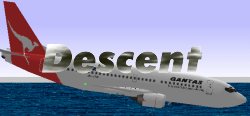 How to fly a B737-300
How to fly a B737-300 How to fly a B737-300
How to fly a B737-300| Technical Data | ||
|
|
History | |
| Downloads |
 The
Boeing 737 is not certified to takeoff without any flaps. An aural warning
advises the pilot if he should have forgotten. To avoid crashes, from now
on, we will take off with flaps. Usually, the setting is flaps 5 (Simu
= flaps 5). Set 'TO-thrust' 94% N1 (Simu = 94% N1; which is NOT full throttle).
Fuel flow is approximately 4.000 kg/h per engine. The Boeing accelerates
approximately 40 seconds before having enough speed for lift-off. At the
rotation speed Vr we lift the nose at a rate of 3°/second. We want
the nose at a BA (body attitude) of 20ø with a light hesitation
around 10ø BA to avoid that the tail should strike the ground during
rotation (explicit problem for the737-400 which is 3,19m longer). The speed
to fly after take-off is V2+15 kt.
The
Boeing 737 is not certified to takeoff without any flaps. An aural warning
advises the pilot if he should have forgotten. To avoid crashes, from now
on, we will take off with flaps. Usually, the setting is flaps 5 (Simu
= flaps 5). Set 'TO-thrust' 94% N1 (Simu = 94% N1; which is NOT full throttle).
Fuel flow is approximately 4.000 kg/h per engine. The Boeing accelerates
approximately 40 seconds before having enough speed for lift-off. At the
rotation speed Vr we lift the nose at a rate of 3°/second. We want
the nose at a BA (body attitude) of 20ø with a light hesitation
around 10ø BA to avoid that the tail should strike the ground during
rotation (explicit problem for the737-400 which is 3,19m longer). The speed
to fly after take-off is V2+15 kt.
|
|
|
|
|
|
|
|
|
|
|
|
|
|
|
|
|
|
|
|
|
|
|
|
 1500
ft AGL
1500
ft AGL
3000 ft AGL
From here we start to accelerate. BA is lowered to ~10°.
Flaps up. We accelerate to 250 kt.
FL100 ft AGL
From here we accelerat from 250 to 300 kt to continue
climb. At the moment we reach Mach 0.74, we continue climb with a constant
mach and BA 5°. N1 increases from 90% to 96% (FL350).

Usually at Mach 0.74. The N1 at FL310 is 77-86% (40mt-60mt)
with BA 2° and trim 2.
Fuel Flow ~1,100-1,200 kg/h
